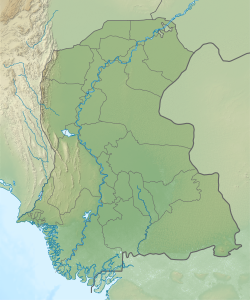Babarlo
Babarlo
Babarloi, Baberloi | |
|---|---|
| Coordinates: 27°38′57″N 68°50′13″E / 27.649122°N 68.836989°E[1] | |
| Country | Pakistan |
| Region | Sindh |
| District | Khairpur |
| Taluka | Khairpur |
| Population (2017)[2] | |
| • Total | 13,636 |
| Time zone | UTC+5 (PST) |
| • Summer (DST) | UTC+6 (PDT) |
Babarlo, also spelled Babarloi or Baberloi,[1] is a village and deh in Khairpur taluka of Khairpur District, Sindh.[3] As of 2017, it has a population of 13,636, in 2,409 households.[2]
History
[edit]Babarlo has the dargah (shrine) for the Muslim pir Makhdoom Pir Syed Rajan Qattaar Jahania, who came to Sindh from Uch Sharif sometime in the mid-19th century.[4] During the saint's urs on 14-16 Shaban, thousands of devotees come to pay their respects to him, offer prayers, and ask for mannats, or favours.[4] This shrine has a unique tradition that, since the saint was reputedly fond of riding donkeys, devotees are expected to offer a donkey in return for a mannat.[4] The donkeys offered this way are said to become "special", which makes them desirable for purchase.[4] The shrine's caretakers sell the offered donkeys and spend the money on the upkeep of the shrine (which is privately maintained).[4]
Babarlo is identified with the Babarlūka mentioned in the Tarkhan-Nama[5] as the residence of the Mughal emperor Humayun for five months beginning in approximately December 1542.[6] The text says, "Having taken up quarters in the town of Lahari (Rohri), he established his own residence within the walls of the delightful garden of Babarluka."[6] A similar account appears in the Chach-Nama, which uses the spelling of Babarlō for the place.[7] The Chach-Nama offers more context behind Humayun's stay: in anticipation for Humayun's arrival, Babarlo "with its four celebrated gardens" was decorated and its fort repaired in order to be a suitable and secure residence for the emperor and his family.[7] It also says that Humayun's camp consisted of some 200,000 people (two lakh), including troops and camp followers; they were so numerous that their camp covered the whole distance between Babarlo and Rohri.[7] It also gives a slightly different duration for Humayun's stay: "about 6 months".[7]
The 1951 census recorded the village of Babarlo (under the spelling "Baberloi") as having an estimated population of about 2,760, in about 650 houses.[8] It had a police station, post office, dispensary, and school at that point.[8]
In November 2021, the rape and murder of a 10-year-old Hindu boy in Babarlo sparked protests in several cities throughout northern Sindh.[9]
References
[edit]- ^ a b "Geonames Search". Do a radial search using these coordinates here.
- ^ a b Population and household detail from block to tehsil level (Khairpur District) (PDF). 2017. p. 13. Retrieved 1 January 2022.
- ^ "List of Dehs in Sindh" (PDF). Sindh Zameen. Retrieved 1 January 2022.
- ^ a b c d e Memon, Sarfaraz (2013). "All about belief: Of mules and mannats". The Express Tribune. Retrieved 15 January 2022.
- ^ Hodivala, Shahpurshah Hormasji (1939). Studies in Indo-Muslim History: A Critical Commentary on Elliot and Dowson's History of India. Bombay. p. 126. Retrieved 6 January 2022.
{{cite book}}: CS1 maint: location missing publisher (link) - ^ a b Elliot, H. M. (1867). "Tarkhán-Náma". In Dowson, John (ed.). The History of India, As Told By Its Own Historians - The Muhammadan Period, Vol. I (PDF). London: Trübner and Co. pp. 316–7. Retrieved 15 January 2022.
- ^ a b c d Mirza Kalichbeg Fredunbeg (1902). The Chachnamah, Vol. 2: The Mussulman period from the Arab conquest to the beginning of the reign of the Kalhórahs. The reigns of the Kalhórahs and the Tálpurs down to the British conquest. Karachi: Commissioner's Press. pp. 81–4. Retrieved 15 January 2022.
- ^ a b Census of Pakistan, 1951: Village List (PDF). p. 4 in section "Khairpur District". Retrieved 1 January 2022.
- ^ "Protests held in many towns of Sindh against criminal assault, murder of Hindu schoolboy". Dawn. 2021. Retrieved 15 January 2022.


